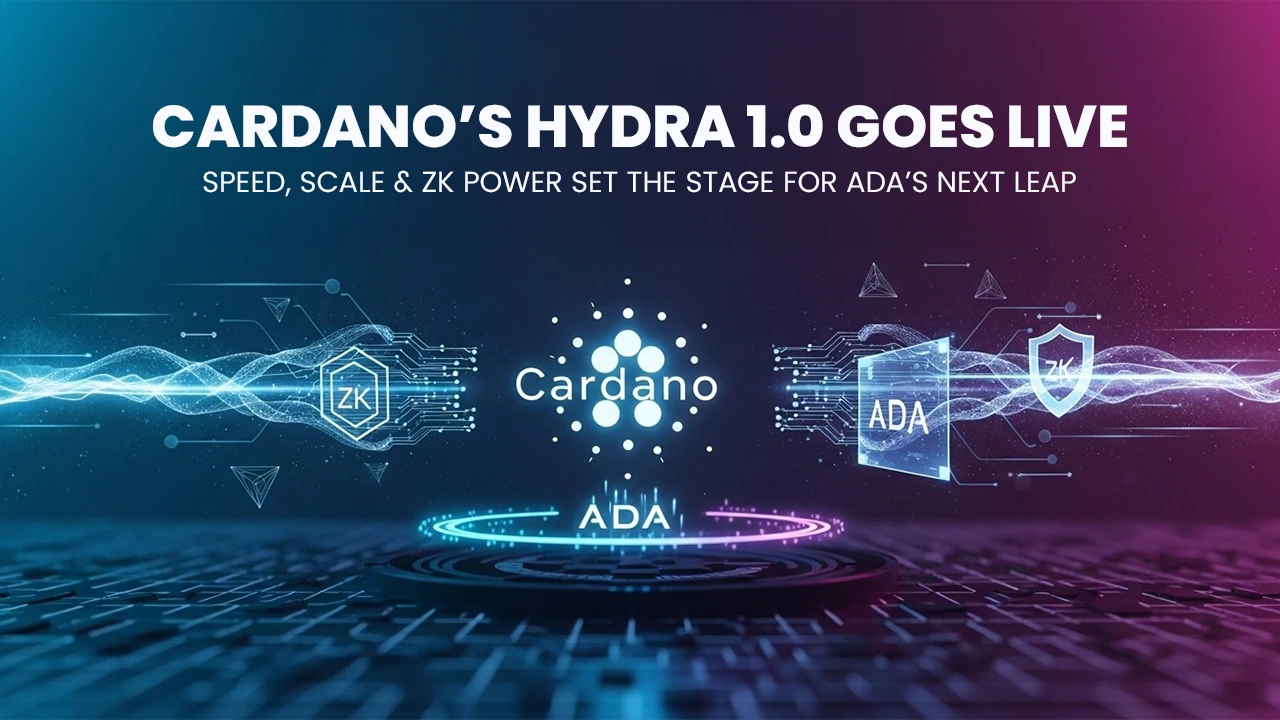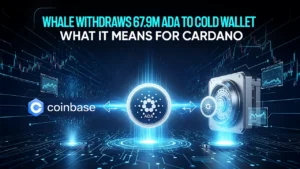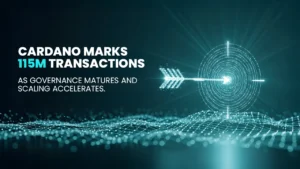Cardano Releases Hydra Node 1.0; Aims for Faster Transactions, Higher Throughput

Cardano crossed a visible milestone. The project’s scaling team shipped Hydra Node 1.0, a production-ready release of its layer-2 line for faster, cheaper transactions. The code is live on public repos and distribution feeds, and multiple trade outlets confirmed the rollout.
- Hydra 1.0 Arrives with Production Signaling
- What the Code and Docs Say
- ZK Work Moves From Blog Posts To Tooling
- Signals From the Community and Developers
- For Investors: What to Watch Next
- Cardano’s Near-Term Execution Checklist
- Conclusion
- Frequently Asked Questions About Cardano’s Launch of Hydra Node 1.0
- How does Hydra 1.0 change everyday usage on Cardano?
- Where is the proof that Hydra 1.0 actually shipped?
- What is the status of zero-knowledge on Cardano?
- Does Cardano use Delegated Proof of Stake?
- What should investors watch in the next quarter?
- Glossary of Key Terms
At the same time, Cardano developers have maintained a steady pace in zero-knowledge research, including an open-source Halo2 verifier prototype designed to bring private proofs to Plutus. Together, the launch and the research narrative point to a simple arc: more throughput now, more privacy and composability next.
The market angle is pragmatic. A production Hydra 1.0 can lower fees for high-frequency activity, especially for apps that can route flows into Hydra Heads. Zero-knowledge, if integrated cleanly, can bring selective privacy and trust-minimized verification to on-chain finance and identity.
Under the hood, Cardano’s Delegated Proof of Stake (DPoS) continues to anchor validator incentives and uptime. The design is often compared with Delegated Proof of Stake in spirit because stakeholders delegate to professional operators, and that delegation keeps consensus predictable at scale. For investors, the test is measurable: throughput, latency, reliability, and a developer pipeline that turns research posts into shipped tools.
ALSO READ: TRON Reboots WBTC as This Gaming Giant Picks Sui to Launch New Survival MMO
• Charles Hoskinson: “Hydra Node v1.0.0 is here.”
Hydra is going to have an awesome 2026 https://t.co/9N3R9YIH6K
— Charles Hoskinson (@IOHK_Charles) October 9, 2025
• Cardanians community account echoing the release.
NEWS: Cardano’s Hydra Node has released 1.0 version 🔥
Hydra is a Cardano side-channel scaling protocol, enabling fast and low-cost transactions.
During the Hydra Doom testing, it reached 1,000,000+ TPS 🤯 pic.twitter.com/2s99kfxdaU
— Cardanians (CRDN) (@Cardanians_io) October 9, 2025
Hydra 1.0 Arrives with Production Signaling
Hydra 1.0 marks a shift from iterative heads-down development to a versioned, production-ready node. Release artifacts are visible on Cardano’s distribution trackers and GitHub, allowing operators to build, test, and deploy with clear version boundaries.
The design targets higher transaction throughput and lower fees by moving interactions off the base chain into Hydra Heads, then settling results on L1. That pattern mirrors how many ecosystems scale while preserving final settlement on the main ledger.
“Hydra Node v1.0.0 is here. DeFi, gaming, and real-time apps are about to level up,” wrote Charles Hoskinson in a post that framed the release as a speed upgrade and a signal to developers.
Coverage from multiple outlets framed the launch as a catalyst for app developers. TheCryptoBasic reported the 1.0.0 milestone, while The Coin Republic highlighted the speed-and-cost objective and situated the release inside Cardano’s broader push toward zero-knowledge features. Market commentary from CoinEdition connected the launch to near-term price levels, but the more durable reading sits with developer adoption and user-visible latency drops. Milestones will show up as smaller fees, more responsive dapps, and repeat usage.
What the Code and Docs Say
Cardano’s developer documentation positions Hydra as a research-rooted layer-2 that increases throughput while keeping security rigorous. In practice, that means fewer onchain steps per user interaction and a path to micro-transactions that do not clog the base chain.
GitHub releases detailed iterative improvements that preceded 1.0, including stability changes to the web API, event-log handling, and cluster coordination components. A production tag gives integrators confidence to ship user-facing features without pinning to nightly builds.
For live apps, reliability beats lab speed. Operators will track crash rates, reorg behavior, and settlement finality between heads and L1. The presence of signed artifacts on CardanoUpdates and reproducible build outputs shortens the time from announcement to deployment. That matters for exchange integrations, wallet support, and enterprise pilots that need audit trails.
ZK Work Moves From Blog Posts To Tooling
Hydra handles scale. Zero-knowledge adds selective privacy and new verification patterns. Input Output Global published a Halo2-based verifier prototype in August, aimed at bringing ZK proofs to Plutus so developers can verify computations or identities without leaking raw data.
The project framed the work as a step toward private, scalable, and interoperable applications on Cardano. With Hydra 1.0 now tagged, the next delivery focus should shift to ZK libraries, developer examples, and wallet flows that make proofs usable for regular users.
ALSO READ: Ark Invest’s $10M Push Into Securitize Signals Wall Street’s Big Shift to Tokenization
Broader industry reporting supports the idea that ZK has crossed from concept to enterprise pilots in 2025. Yahoo Finance recently highlighted how mainstream firms are exploring ZK for privacy and compliance, which dovetails with onchain finance and regulated identity use cases. The more Cardano can ship reference implementations that fit compliance needs, the faster we reach production deployments in fintech and tokenized assets.
Signals From the Community and Developers
The immediate reaction came from the core founder account and community educators who track Cardano’s roadmap. Hoskinson’s post flagged a “new era of speed and scalability.” Community curators amplified the 1.0 tag and encouraged operators to test. These signals matter because developers watch for the consensus view: a release is real when maintainers say it is ready, when the artifacts are posted, and when early adopters confirm that real workloads run.
Hydra is going to have an awesome 2026 https://t.co/9N3R9YIH6K
— Charles Hoskinson (@IOHK_Charles) October 9, 2025
Trade press also pushed analysis pieces connecting Hydra’s release to Cardano’s near-term direction. Articles in TheCoinRepublic and TheCryptoBasic framed the launch as a speed-and-cost improvement and noted the ongoing ZK work. While price-target commentary is common, the programmatic angle is clearer: more capacity on L2 plus privacy tooling creates room for payments, gaming, and identity flows that demand sub-second response.
For Investors: What to Watch Next
Investors can filter the noise with operational checks. First, look for wallet and dapp releases that enable Hydra-based interactions, not just headlines. Second, track ZK developer activity through published repos, libraries, and starter kits that show real usage. Third, monitor stake pool metrics, saturation, and delegation flows, since a healthy validator ecosystem, whether described as DPoS or delegation-based PoS, supports uptime for every app on-chain. Finally, watch fees and latency from the user’s point of view. If a payment or swap runs faster and cheaper next month than it did last month, the thesis is working.
Trading sites have already linked Hydra headlines to near-term ADA price levels. CoinEdition noted price hovering around key support as sentiment steadies post-launch. Short-term levels matter to traders. Long-term returns depend on adoption and reliability that compress fees and attract non-crypto users.
ALSO READ: Cardano Throws Governance, Cross-Chain Swaps Into the Ring Ahead of ETF Deadline
Cardano’s Near-Term Execution Checklist
| Area | What Shipped | Why It Matters | Next Verification Step |
| Scaling | Hydra Node 1.0 release artifacts on official feeds and repos | Gives integrators a stable target for production | Wallet and dapp updates that expose Hydra flows to end users, monitored latency and fees |
| Privacy | Halo2-based ZK verifier prototype for Plutus | Opens selective privacy and new verification patterns | Libraries, reference apps, and audits that move ZK from prototype to production |
| Community | Founder and educator accounts signal readiness on social | Aligns developers on versioning and rollout timing | Operator reports, tutorials, and conference demos tied to 1.0 |
| Governance | Delegation-based PoS, DPoS-style incentives for operators | Supports uptime, predictable settlement, and performance | Stake pool saturation metrics, stability through traffic spikes |
| Market | Trade press confirmation and investor coverage | Improves visibility for ecosystem partners | Exchange integrations and enterprise pilots that cite Hydra or ZK in documentation |
Conclusion
Cardano’s Hydra Node 1.0 gives developers a production-ready path to faster, cheaper transactions. The code and artifacts are public, and the rollout has been corroborated by trade press and community leads. In parallel, the Halo2-Plutus verifier prototype signals real progress on zero-knowledge functionality.
The direction is consistent: more capacity now, more privacy soon. The validator and delegation structure, often described as Delegated Proof of Stake (DPoS) because holders delegate to professional operators, continues to supply the steady finality that scaling layers require.
The next proof will be visible in wallets, dapps, and audits. If users see lower fees and faster response while developers get usable ZK libraries, the platform advances from roadmap to reality. That is the bar the market will apply in the weeks ahead.
Frequently Asked Questions About Cardano’s Launch of Hydra Node 1.0
How does Hydra 1.0 change everyday usage on Cardano?
It gives developers a stable, production-tagged node to route high-frequency interactions into Hydra Heads, then settle back to L1. Users should see lower fees and faster response as wallets and dapps adopt it.
Where is the proof that Hydra 1.0 actually shipped?
Release artifacts are visible on CardanoUpdates and GitHub. Operators can pull tagged builds, read notes, and test deployments. Trade coverage confirms the release timing.
What is the status of zero-knowledge on Cardano?
An open-source Halo2-based verifier prototype exists for Plutus. The next steps are libraries, examples, audits, and wallet integrations that bring ZK into mainstream app design.
Does Cardano use Delegated Proof of Stake?
Cardano runs a proof-of-stake protocol with stake delegation to pools. Many investors describe this as DPoS-style because holders delegate to professional operators who secure the network. The delegation model complements Hydra’s need for predictable base-layer finality.
What should investors watch in the next quarter?
Hydra adoption in major wallets and dapps, published ZK libraries and audits, stake pool stability during traffic surges, and user-visible fee and latency compression. CoinEdition’s near-term price view is a sentiment barometer, but adoption metrics will carry more weight.
Glossary of Key Terms
- Hydra: Cardano’s layer-2 family for high-throughput, low-fee interactions that settle on L1.
- Hydra Head: A state channel-like construct where parties transact off-chain and settle results on L1.
- Plutus: Cardano’s smart-contract platform that executes on the extended UTXO model.
- Halo2: A proving system used to build zero-knowledge proofs.
- Zero-Knowledge Proof (ZKP): A method to prove statements without revealing the underlying data.
- Delegation: Assigning stake to a pool operator who participates in consensus on the delegator’s behalf.
- DPoS-style Model: A delegation approach where token holders empower validators or pools, aligning incentives for uptime and performance.
- Final Settlement: Posting the definitive state to the base chain after off-chain interactions.
- Throughput: The number of transactions a network can process per second.
- Latency: The time it takes for a transaction to be confirmed and recognized by applications.




